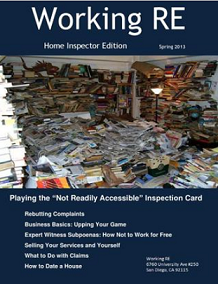
|
Home Inspectors Edition | Circulation 22,000 | Advertise | Subscribe | |
Published by OREP, E&O Insurance Experts | February 2013 |
 Click to Read Current Issue |
>
Click to Print
|
Building and growing your home inspection
busines should be top of mind for any professional in today's fast paced
real estate market.
>
The new
Working RE Magazine- Home Inspector Edition
has been published!
If you haven't already,
take a look!
>>Cover
Story:
Playing the "Not Readily Accessible" Inspection Card
Demystifying Sales and Marketing for Home Inspection Professionals
By Brian Bell, VP Sales and Marketing at Carson Dunlop
Operating your Home Inspection business comes
with many challenges and the most neglected part of the business is
always on the sales and market front. Most
inspectors say sales and marketing costs a lot and has no guaranteed
return, which is why they place it on the backburner.
This article is designed to
demystify the sales and marketing process
and provide home inspectors with an easy and hands-on approach
to sales and marketing. Building and growing your home inspection
business should be top of mind for any professional in today’s fast
paced real estate market.
Sales & Marketing: What’s the Difference?
Marketing is about spreading the word about your products and services
through many different media in order to create awareness. Think of
your website, press releases, product sheet information and social
media as marketing tools to help increase awareness about you and your
services.
Sales is about building one-on-one relationships with prospective
clients or partners to directly tell them how your products and
services solves a problem for them or their clients. When you
effectively combine sales and marketing, you are able to take your
Home Inspection business to the next level.
Do you Want to Make More Money?
The vast majority of Home Inspectors
answer YES which means they have to make a major commitment:
CHANGE.
You have to be
committed to doing things
differently in order to build and grow your business. Doing the same
things over and over again and expecting
different results is the definition of insanity.
Now that you have taken the most important step of committing
to change, the next step in the process is to build a sales and
marketing plan. We know this sounds like a complex and difficult task,
but in fact it is relatively straight forward and easy.
We have developed a simple five
step sales and marketing process and created an easy-to-use free
template that can be downloaded at
www.carsondunlop.com/S&Mtemplate
(story continues below)

(story continues)
How important is setting a goal?
This story makes it clear: 3% of the 1979 Harvard MBA graduates have
made 10 times as much money as the other 97%. Why is that? The big
difference was they wrote down their goals and their specific plans
to achieve them. The majority of the graduates had set no goals and
had no idea where they were going.
Goal Setting: Making SMART Goals
Your sales goal might be to Achieve $100,000 in sales in 2013.
Let's look at it.
Is it
Specific? Yes, $100,000
is a very specific number.
Is it Measurable?
Absolutely, I can determine whether I get to $100,000 in sales.
Is it Achievable? Make
sure it is. If sales last year were $80,000, a target of $100,000
seems very achievable.
Is it Relevant? It's
relevant to your ability to put food on the table.
Is it Time-bound? The
guideline of 2013 gives a very specific time frame.
Your Plan
The first important rule in building your plan is that “It's not
about you!”
Look at everything from the perspective of your audience. They don't
care about the features
of your company. They care about the
benefit to them. Most
don't care about your qualifications. They assume Home Inspectors
are qualified and know how to inspect homes. They want you to
help them. Try thinking
like a customer and asking yourself this question, "What do I want
from a Home Inspection?" The answer might be, "Help me decide
whether to buy this house." Or they might say, "Tell me what
condition it's in so I can make a good decision." That's what they
want from you. That's pretty simple.
What else might they want?
·
Be available when I need
you.
·
Talk to me in simple
language.
·
Be friendly and patient.
·
Answer my questions.
·
Give me a report I can
understand.
·
Be there if I have
questions down the road.
Can you do all those things?
The goal is to create incredible value
for your clients. At the
risk of being repetitive, it's not all about you; it's about them.
·
What problem can you
solve for them?
·
What need can you
address?
·
How can you make their
lives easier?
·
How can you make them
more successful?
Your marketing message answers these questions for your audience.
Who is Your Audience?
Is it prospective home buyers, real estate sales professionals, home
sellers, lenders, someone else? Your message changes because
different audiences have different needs.
Your Value Proposition or Unique Selling Proposition (USP)
Everyone should have an elevator pitch. When people ask what you do
or who you are, you need to be able to explain it in 10 to 30
seconds. The first part is about you and the last part is about
them.
Here's our UPS, "We are an engineering company that has been focused
on Home Inspection since 1978. We are pioneers and one of the
largest inspection firms in Canada. We are passionate about using
our knowledge and experience to help home buyers, owners and sellers
make informed decisions on the biggest investment they'll ever
make."
Create your own value proposition based on what you bring and how
you help. And of course, you probably have different USPs for home
buyers and real estate sales professionals.
Don't Make it About Price
Price should never be part of your value proposition as it is not a
differentiator in your business. We view Home Inspection as a
professional consulting practice that helps customers make an
informed decision when buying or selling a home.
Focus on value by providing more benefits to your clients and
partners instead of lowering your price. Ask yourself the question:
“Are the most successful Home Inspection companies the cheapest?”
People don't typically buy the least expensive house on the market,
or the cheapest car on the road. They buy what represents the best
value to them. That's how
they should choose their Home Inspection company as well.
How You Deliver the Message
We said your message will depend on your audience, so decide which
market(s) you will target. Here's a partial list to get you started.
·
Home buyers
o
Pro
§
They will benefit directly from your service
§
Most are looking for a Home Inspector
o
Con
§
It's hard to know who's about to buy a home; message has to go out
broadly
§
People only buy a house once every 5 to 7 years; one-time event
·
Real estate sales
professionals
o
Pro
§
They work with home buyers and sellers all the time; possible stream
of business rather than a one-time event
§
They are easy to identify and target
o
Con
§
Their goals are different than the buyer's to some extent
§
They are an intermediary between you and the buyer
§
They are easy for your competition to identify and target
Now, prepare your
messages to meet the needs of each audience. Here are a couple of
starters you can build on.
Home buyers needs: protection, information, reassurance.
Real estate sales professionals
needs: commission, liability
protection, referrals.
What are Your Messages?
We can't tell you, because we don't know what you bring. You are
unique. Think about matching your assets to the needs of your
audience. Remember, most will not be challenging your technical
competency, they assume it. Go back and look at the list of things
they might want.
Table Stakes
We said that people will assume you are going to perform a competent
inspection. There some other things that you need to do well. While
they are not unique skills, it's amazing how many people mess these
up. These are basic business skills and life skills; not at all
specific to Home Inspection. They are however, critical to success
in Home Inspection.
These are things like first
impressions, how your website looks and feels, how you answer your
phone, how easy it is to make an appointment with you, whether you
show up on time, how your vehicle looks, your appearance, your
smile, your first words, your manner and attitude, your respect,
patience and interest in people, the promptness and usability of
your report and your availability to answer questions after the
fact. While you may not think of these as your marketing messages,
each of these sends a message to your audience.
Somewhat sadly, if you get these
right every time, you have beaten 95% of your competition.
Differentiate Yourself
Go back to your unique selling
proposition. Think about your background. Think about your clients’
wants and needs. This obsolete list may give you some ideas about
how you can make yourself memorable:
·
We never keep you
waiting - if we're not on time for the inspection, it's free.
·
Will provide free
technical consulting firms long as you own your home.
·
We offer a money back
guarantee. If you are ever less than completely satisfied with us
for any reason, we will gladly return your fee, no questions asked.
(Some offer a double or even triple money back guarantee.)
·
Give people a tape
measure with your logo.
·
Give people your report
on a memory stick that they can use. Of course it has your logo.
·
Give or send people
change of address cards.
·
Bring colouring books
and crayons to the inspection for children.
·
Bring water and/or
healthy snacks to the inspection.
·
Give clients a water
bottle or coffee mug.
·
Brings slip on booties
that people can put over their shoes as they walk through the house.
·
Build a custom
maintenance program for your clients based on the inspection report.
·
A carwash coupon on
their windshield.
·
Cut their grass on
move-in day.
·
Send handwritten thank
you card.
·
Offer a home warranty.
·
Offer a free one-year
update inspection.
Summary
Building your Home Inspection
business is not a one-time event; it requires an ongoing commitment
and effort. The information in this article is excerpted from Carson
Dunlop’s Building Your Home Inspection Course. This course provides
you with the tools to help you take your business to the next level.
To learn more visit
www.carsondunlop.com/tools
In Toronto, brick foundation walls were popular until about 1935. In
other parts of the province, you will find no brick foundation walls
at all. With the exception of custom built houses, most houses built
with concrete block foundations are pre 1970. Most subdivision
houses built in the 70s or newer have poured concrete foundations.
Most brick houses in Ontario were solid masonry construction (two
widths of brick) up until the late 1960s. Most brick houses built
after 1970 were brick veneer construction (one width of brick with a
wood stud wall behind).
![]() If
you stand in an unfinished basement and look up at the sub flooring,
you will find that most houses before 1965 used plank sub flooring.
After 1965, most houses have plywood sub flooring, until the early
1980s, when wafer board sub flooring became popular (with the
builders at least).
If
you stand in an unfinished basement and look up at the sub flooring,
you will find that most houses before 1965 used plank sub flooring.
After 1965, most houses have plywood sub flooring, until the early
1980s, when wafer board sub flooring became popular (with the
builders at least).
Aluminum wiring began to be used residentially in about 1965,
however, it did not really catch on until about 1970. When was it
banned? It was never banned. However, it received so much bad press
that aluminum wiring stopped going into houses in about 1978. To
this day, aluminum wiring is still used to bring power into the
house from the street.
As you are probably aware, knob and tube electrical wiring makes
insurance companies very nervous. Knob and tube wiring was
superseded by conventional modern wiring in the late 1940s. Even
though wiring looked modern through the 1950s, it was not until 1960
that modern wiring contained a ground wire. Therefore, houses built
before 1960 have two prong outlets as opposed to modern electrical
outlets which are designed for three prong plugs.
Before 1950, supply plumbing was galvanized steel. Houses with
galvanized steel supply plumbing also tended to have cast iron waste
plumbing. In about 1955, waste plumbing was more likely to be copper
than cast iron. In the late 1960s, the price of copper went through
the roof. Waste plumbing became plastic very quickly. (It was this
jump in the price of copper that also led to the use of aluminum
wiring.)
Old houses have plaster on the walls and ceilings, whereas new
houses are built with drywall. When did the change occur? While
there was no magic day when plasterers quit and drywallers began,
most houses built before 1960 are plaster and most houses after are
drywall.
Dating houses can be helpful for a number of reasons; for example,
furnaces sold and installed 20-25 years ago have a life expectancy
of 20-25 years. Therefore, most houses built in the early 1970s have
a new furnace or will need one shortly. Most houses built in the
early 1980s were built with asphalt shingle roofs that last up to 15
years. Again, most of these houses either have a new roof covering
or need one. The good news about a 1982 house in need of new
shingles is that it couldn’t possibly contain Urea Formaldehyde Foam
Insulation. It was banned in December of 1980!!
This story is used with permission of Carson Dunlop, providing
inspection services and home inspector training, education and
reporting systems. For more information visit:
www.carsondunlop.com.
ATTENTION: You are receiving WRE Online News because you opted in at WorkingRE.com or purchased E&O insurance from OREP. WRE Online News Edition provides news-oriented content twice a month. The content for WRE Special Offer Editions is provided by paid sponsors. If you no longer wish to receive these emails from Working RE, please use the link found at the bottom of this newsletter to be removed from our mailing list.



